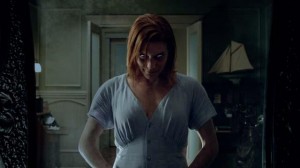
It can be very tough to make an inanimate object a source of pure terror. The new film Oculus attempts to inspire intense fear out of an antique mirror. While it isn’t entirely successful, the movie does evoke more shivers than expected and just enough surprise jolts to entertain viewers looking for a scare.
The story follows 21-year old Tim (Brenton Thwaites), recently released from a psychiatric home after more than a decade because of a devastating family tragedy. Convinced that his memories of an evil, antique mirror were delusions caused by mental trauma, he hopes to move on with his life. However, after being reunited with his sister Kaylie (Karen Gillan), Tim immediately learns that she still believes supernatural forces were involved. The obsessed sibling insists that her brother make good on his childhood promise to help her destroy the looking glass once and for all. Tim relents, but not before the oculus starts to fight back. You should have just dropped it off at the city dump, people!
 What follows is a battle of wills between both the siblings and the mirror itself. There are a few interesting storytelling devices used to engage viewers. Flashbacks are used sparingly, giving audiences a taste of what occurred but not an outright explanation. Early on, the story lends enough doubt to the sister’s claims and suggests that she might be more unstable than her brother. The two leads carry the movie well and while occasionally overplayed, their bickering is fun to watch and plays enjoyably into the broken mind theory.
What follows is a battle of wills between both the siblings and the mirror itself. There are a few interesting storytelling devices used to engage viewers. Flashbacks are used sparingly, giving audiences a taste of what occurred but not an outright explanation. Early on, the story lends enough doubt to the sister’s claims and suggests that she might be more unstable than her brother. The two leads carry the movie well and while occasionally overplayed, their bickering is fun to watch and plays enjoyably into the broken mind theory.
The filmmakers also know how to elicit a guttural reaction from the audience. While the movie isn’t explicitly violent, there are upsetting moments revolving around circumstances everyone can relate to – this includes fingernails being torn off and mouth related injuries. These scenes are effectively wince-inducing. Events get really freaky after flashbacks start intersecting with the present day versions of the characters. The flick skillfully edits together these two timelines, holding back information in a way that keeps attention and interest. Soon the adults aren’t sure what’s going on and find themselves doing things that they have no memory of. The sound design also works, with long periods of silence punctuated with low frequency hums that effectively convey a sense of unease.
However, the ending doesn’t quite provide as big a shock or twist as one would anticipate. The movie is creatively put together – so much so that perhaps this reviewer was over-thinking it as it played out and ultimately expected a bigger pay off. In the end, it doesn’t leave viewers with as big a thrill as one would hope for. And like most films of its ilk, one can’t help but feel that the makers are intending to milk the concept of a haunted mirror terrorizing families in theaters for several years to come.
While it isn’t quite as satisfying as hoped, it manages to seamlessly combines timelines and successfully create an eerie mood, as well as provide a couple of decent jolts. Oculus may not be a horror classic, but it is a competent effort that will please some horror fans.


